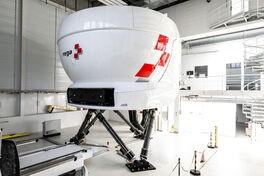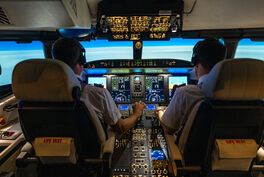We are your expert partner for initial and recurrent training on the Challenger 600 series (Challenger 604/605/650). Our instructors are active pilots with many years of experience in this aircraft type. Comprehensive course material and modern training tools enable you to optimise your preparation for each session.
The EASA FFS Level D approved simulator is of the Challenger 650 variant and is located at the Lufthansa Aviation Training centre at Zurich Airport.


Pilot Training Courses
Our ATO approvals cover type ratings, TRI/SFI courses, as well as Differences Trainings. Further, we offer license revalidations and renewals.
Challenger 605/650 Type Rating course footprint:
- 58 hours of Ground Training (including 12 hours of Systems Integration Training on FFS)
- 5 sessions Flight Training
- 1 session Skill Test
Entry requirements for the Challenger 605/650 Type Rating course:
Applicants for the type rating course shall have:
a. Have at least 70 hours of flight experience as PIC on aeroplanes
b. Hold or have held a multi-engine IR(A),
c. Have passed the ATPL(A) theoretical knowledge examinations according to Part-FCL
d. Except when the type rating course is combined with an MCC course:
- Hold a certificate of satisfactory completion of an MCC course in aeroplanes, or
- Hold a certificate of satisfactory completion of MCC in helicopters and have more than 100 hours of flight experience as a pilot on multi-pilot helicopters; or
- Have at least 500 hours as a pilot on multi-pilot helicopters; or
- Have at least 500 hours as a pilot in multi-pilot operations on single-pilot multi-engine aeroplanes, in commercial air transport
e. For the issue of the first multi pilot type rating, they shall, before starting the type rating training course, have completed the training course specified in FCL.745.A (advanced UPRT) or
- have completed, within the preceding 3 years, the training and checking in accordance with points ORO.FC.220 and ORO.FC.230 of Annex III (Part-ORO) to Regulation (EU) No 965/20212 or
- have completed the training specified in point FCL.915(e)(1)(ii)
The validity of the type rating is one year. The revalidation of the rating (LPC – License Proficiency Check) can be conducted within 90 days prior to the expiry date stated on the license. Our examiners are registered with numerous civil aviation authorities and possess the capability to conduct proficiency checks or skill tests for all EASA member states.
If your type rating has expired, we provide renewal training sessions aimed at restoring the proficiency necessary for the safe operation of the Bombardier Challenger 605/650. The extent of refresher training required is assessed individually, taking into account the applicant's on-type experience, the duration since the expiry of the rating's validity period, and the pilot's overall flight experience. Our training department meticulously reviews your documentation and devises a bespoke training programme according to your proficiency level. For comprehensive details regarding the regulations and procedures mandated by various national authorities, please contact our sales department.
The TRI/SFI course consists of 3 modules:
Module 1: Teaching and Learning
This module covers an introduction to training and instructing techniques, candidate evaluation, and lecturing. Applicants who already possess or have held a flight instructor license will receive credit for this module.
Module 2: Technical Course & FFS Training
The technical course equips the instructor candidate with the ability to teach the type-specific syllabus for the Challenger 605/650. Special emphasis is placed on multi-crew cooperation, focusing on panel flow patterns, checklist strategy, workload management, and task sharing. During flight training, candidates perform instructional exercises necessary to qualify for type rating training privileges.
Module 3: Assessment of Competence
The TRI/SFI course concludes with an Assessment of Competence. Depending on the desired privileges, the assessment occurs either on the FFS (for TRI restricted with privileges) or on the aircraft (for TRI unrestricted).
Operator Training Courses
As stipulated in EASA PART-ORO.FC130, every flight crew member is required to undergo recurrent training specific to the type of aircraft they operate. AAA tailors an effective and practical training programme that meets the requirements outlined in the customer’s operations manual. Typically, the training is structured into a three-year cycle, comprising both ground school sessions and flight instruction, encompassing all abnormal and emergency procedures. If necessary, we can also supply type-rated pilots as seat-support (PM - Pilot Monitoring). Additionally, other modules can be incorporated into the training as needed.
Depending on the training specified by the airport authority and the operators’ manuals, the course familiarises pilots with all aspects of operations at the respective airport, such as regulatory requirements, airport constraints, approach and departure operations, and human factors/CRM techniques that aid in safe flight operations. During an extended briefing, topics relevant to the operation are discussed, like AFM limitations, performance planning and criteria, the importance of thorough pre-planning for each arrival and departure, CRM issues regarding these operations, aircraft-specific procedures, and aircraft-specific performance calculations. In the subsequent practical FFS training, all aspects of approach and departure operations as well as ground operations are trained. The FFS is equipped with up-to-date navigational and terrain information which is modelled in exact detail, providing a highly realistic environment.
The Low Visibility Operations (LVO) training prepares pilots to conduct ground operations, low visibility take-offs, and approaches (normal/emergency operations) as approved by the respective authority.
FFS Specification
-
 2-7-201_CL650_CH-133_Certificate.pdf FSTD Qualification Certificate Bombardier Challenger 650 292 KB
2-7-201_CL650_CH-133_Certificate.pdf FSTD Qualification Certificate Bombardier Challenger 650 292 KB